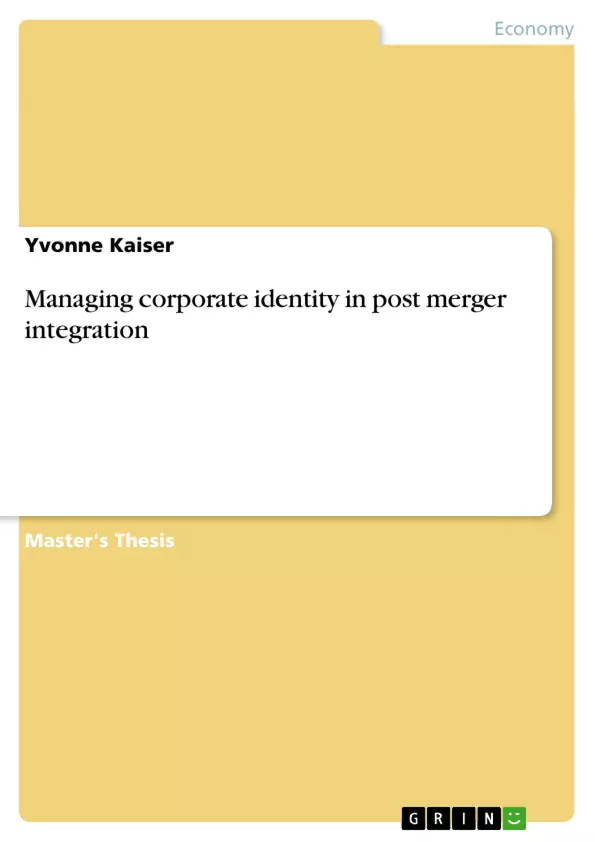When corporations are merging a tendency towards standardisation of organisations,
processes and systems arises. Mergers of companies also lead to a concentration
of increasingly larger trusts and holdings. Still the corporation is supposed to
remain unmistakable and unique in order to preserve its attractiveness for customers,
employees, suppliers, investors, in short, for a network of stakeholders. Only corporate
identity (CI) has the efficiency range required to address and reach all these groups
whose needs have to be considered.
This present work examines the concept of corporate identity, its application in
the corporate environment, and the opportunities for the targeted and strategic steering
under the background of mergers and acquisitions. The goal is to develop a concept
and an approach how to start working on corporate identity and to set interventions
during the postmerger process to support a successful integration.
For the reasons of the different meanings and the different understanding of
the terms 'Corporate Identity' and 'Mergers & Acquisitions' (M&A) the present work develops
both a structural model for the analysis of the individual components of corporate
identity and a phase model for the configuration of integration. Based on this
analysis the contexts of effects between and the opportunities for influencing the individual
dimensions of CI are proven within the scope of postmerger integration (PMI),
and instruments for the targeted impact and steering are represented. The validity of
the elaborated approach of CI management within the framework of PMI is examined
within the frame of two case studies of the two largest telecommunication companies
presently operating in Germany. Activities are deducted from the results of the secondary
analysis and from the empirical studies and are summarised in terms of a CIoriented
model of procedure for postmerger integration optimised for success.
Inhaltsverzeichnis (Table of Contents)
- INTRODUCTION
- CORPORATE IDENTITY IN THE INFORMATION SOCIETY
- THE MERGER WAVES
- ISSUE OF THIS WORK
- GOALS AND APPROACH OF THIS WORK
- GOALS
- APPROACH
- SCOPE AND DEFINITION OF TERMS
- CORPORATE IDENTITY
- FUNDAMENTAL CONSIDERATIONS ABOUT THE TERM CORPORATE IDENTITY
- THE TERM 'CORPORATE IDENTITY'
- Dimensions
- Instruments
- Components
- Characteristics and Delimitation
- MERGERS AND ACQUISITIONS
- THE TERM MERGERS AND ACQUISITIONS
- MERGER MANAGEMENT
- INTEGRATION SUCCESS MEASUREMENT
- SOLUTIONS IN SCIENCE AND LITERATURE
- SUMMMIG UP EXPLANATIONS FOR DIFFERENCES IN INTEGRATION SUCCESS
- SUMMARY AND DEFINITION OF TERMS FOR THIS WORK
- CORPORATE IDENTITY
- IDENTITY COMPOSITION
- AREAS OF CONFLICT
- INFLUENCING COMPONENTS OF CORPORATE IDENTITY
- IMAGE
- The term and concept
- Organisational image
- Effects of image
- Composition of image
- CORPORATE CULTURE
- The term and concept
- National and organisational culture
- Effects of Culture
- Composition of organisational culture
- CORPORATE PERSONALITY
- Function of strategy
- Vision and goals
- Values and principles
- IMAGE
- MANAGING CI-RELATED INTERVENTIONS DURING INTEGRATION
- AREAS OF CONFLICT
- PROGRAMME MANAGEMENT
- PROGRAMME ORGANISATION
- TEAM STAFFING
- INTEGRATION SPEED
- PROGRAMME FLOW
- PROGRAMME CONTROLLING AND INTEGRATION AUDIT
- INSTRUMENTS TO INTERVENE
- CORPORATE BEHAVIOUR
- Elements
- Internal
- External
- CORPORATE COMMUNICATION
- Elements
- Internal
- External
- CORPORATE DESIGN
- Elements
- Internal
- External
- CORPORATE BEHAVIOUR
- PRELIMINARY EXAMINATIONS AND MEASUREMENT OF EFFECTS
- PROBLEMS
- METHODICAL APPROACHES
- INSTRUMENTS
- Preliminary examination and assessment
- Evaluation and continuous measurement
Zielsetzung und Themenschwerpunkte (Objectives and Key Themes)
This dissertation examines the concept of corporate identity, its application in the corporate environment, and the opportunities for targeted and strategic steering in the context of mergers and acquisitions. The main goal is to develop a concept and approach for managing corporate identity during post-merger integration to ensure a successful integration process. This work explores the complexities of defining and managing corporate identity in the context of mergers and acquisitions, highlighting the potential conflicts that arise and providing tools for effective intervention.
- The impact of corporate identity on stakeholder relationships
- The role of corporate identity in post-merger integration
- The challenges and opportunities of managing corporate identity during mergers and acquisitions
- The development of a comprehensive approach to corporate identity management in post-merger integration
- The application of this approach in real-world case studies
Zusammenfassung der Kapitel (Chapter Summaries)
- Introduction: This chapter introduces the concept of corporate identity and its importance in the information society. It discusses the increasing prevalence of mergers and acquisitions and the challenges these pose to corporate identity management. The chapter concludes by outlining the research goals and approach.
- Scope and Definition of Terms: This chapter provides a comprehensive definition of corporate identity, exploring its various dimensions, instruments, components, and characteristics. It also defines mergers and acquisitions, discussing merger management and integration success measurement. The chapter culminates in a clear definition of the key terms used throughout the dissertation.
- Identity Composition: This chapter delves into the areas of potential conflict that arise when managing corporate identity during post-merger integration. It then examines the key components of corporate identity—image, culture, and personality—analyzing their impact and composition in the context of mergers. This chapter provides a foundation for understanding how to manage these elements effectively.
- Managing CI-related Interventions during Integration: This chapter focuses on the practical aspects of managing corporate identity interventions during the post-merger integration process. It explores the key areas of conflict, discusses programme management, and outlines various instruments for intervening in the corporate behaviour, communication, and design. The chapter emphasizes the need for a comprehensive and strategic approach to CI management.
Schlüsselwörter (Keywords)
This dissertation explores the crucial intersection of corporate identity, mergers & acquisitions (M&A), and post-merger integration (PMI). It focuses on key concepts such as stakeholder engagement, organizational change, communication strategies, and cultural integration. The work examines the impact of corporate identity management on the success of post-merger integration and provides practical tools for effective intervention.
- Citar trabajo
- Yvonne Kaiser (Autor), 2003, Managing corporate identity in post merger integration, Múnich, GRIN Verlag, https://www.grin.com/document/26532



